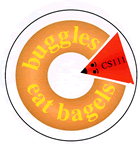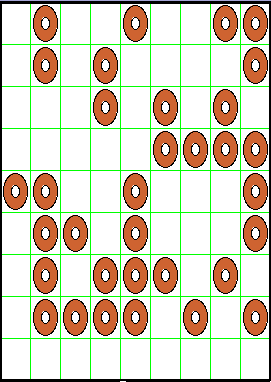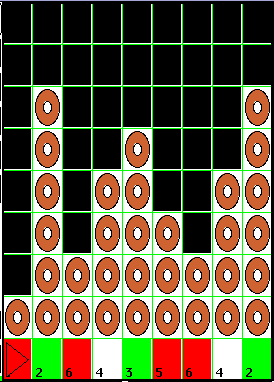
|
Problem Set 6 Due on Wednesday, October 31 at the start of lab |

|
Problem Set 6 Due on Wednesday, October 31 at the start of lab |
The purpose of this problem set is to give you more experience with recursion and writing recursive methods that return values.
The starter code for Tasks 2 and 3 is available in
the ps06_programs directory in the cs111 download
directory on the CS server.
Exponentiation.java file from Task 1;
SierpinskiQuiltWorld.java file from Task 2;
HarvestWorld.java file from Task 3;
Staple these together, and submit them at the start of class on the due date.
Save your new Exponentiation.java file and the modified
SierpinskiQuiltWorld.java and HarvestWorld.java
files in the ps06_programs folder. Submit the entire
ps06_programs folder to your drop folder on the cs111
server.
Write an application that takes two numbers, a base and an exponent, and outputs the exponentiation of the two numbers, i.e., the base raised to the exponent power. For instance, if your application is given the base 3 and the exponent 7 then your application should output the number 2187 since 37 = 2187.
You should start by creating an Exponentiation class
in a file namd Exponentiation.java. Your
Exponentiation class should have two class (i.e., static)
methods:
main method with the following formal parameter:
String[] args. The main
method should carry out the following steps:
System.out.println) the
integer returned by the recursive method
invocation.
The figure below illustrates the execution of a working
Exponentiation application using the "Interactions"
tab at the bottom of the Dr. Java window.
sierpinskiQuilt(black,cyan,1) |
sierpinskiQuilt(black,cyan,2) |
sierpinskiQuilt(black,cyan,3) |
sierpinskiQuilt(black,cyan,4) |
Tragically, Gilda is an artist with no programming background (where was media arts when she went to college?), so she has to draw all her designs by hand. Since this is extremely error prone and tedious, the Built-a-Quilt company has decided to hire a Java programmer who can express Gilda's designs in PictureWorld. Impressed by your work on the previous Problem Set 5 problems, Built-a-Quilt hires you to implement the following method:
public Picture sierpinskiQuilt (Color c1, Color c2, int n) Assume that n >= 1. Returns one of Gilda's Sierpinski quilts that is constructed out ofn-level Sierpinski gaskets colored withc1andc2.
When you carefully study Gilda's quilt patterns, you see that there are two auxiliary methods that would greatly simplify your task:
For example:public Picture sierpinski (Color c1, Color c2, int n) Assume that n >= 1. Returns a picture of annlevel sierpinski gasket whose "body" has colorc1and whose "holes" have colorc2. The resulting picture should be a "lower left" triangle -- that is, a triangle two sides of which are the left and bottom edges of the frame in which it is displayed.
sierpinski(black,cyan,1) |
sierpinski(black,cyan,2) |
sierpinski(black,cyan,3) |
sierpinski(black,cyan,4) |
public Picture triangles (Picture tri, int n) Suppose that tri is a "lower left" triangle and n >= 1. Returns a picture whose lower left triangle is filled with tri and whose upper right triangle is an n-level Sierpinski gasket whose "body" is white and whose "holes" are filled with copies of tri.
For example, suppose that rgTri is the following lower-left triangle:
rgTri |
Then here are some examples of triangles() called with rgTri
and various level numbers:
triangles(rgTri,1) |
triangles(rgTri,2) |
triangles(rgTri,3) |
triangles(rgTri,4) |
sierpinski(),
triangles(), and sierpinskiQuilt() methods
in the file SierpinskiQuiltWorld.java in the
SierpinskiQuilt folder. In addition to the usual methods
of the PictureWorld
contract, you may also use the following methods:
public Picture triangle (Color c) Returns a "lower left" triangle filled with color c. public Picture rotations (Picture p) Returns a picture consisting of four copies of p rotated around the center of the picture.
To experiment with a working version of a solution to this problem, run the applet SierpinskiQuiltWorld in a web browser. Your solution should produce the same pictures as this sample solution applet.
Note: Please read this entire problem carefully. Simply generating the correct final pattern is not enough to get full credit. Each specified method must behave as described below. Programming to a specification is an important part of software engineering.
Bagels in BuggleWorld grow in fields (you knew
that, didn't you?). Twice a year the Harvester buggles
go out and harvest bagels so that buggles in BuggleWorld will have
bagels to eat and play with throughout the year. Bagels are the most
important commodity in BuggleWorld. Therefore, their harvesting
procedure is quite complex and elaborate. It is described
below:
Each Harvester is assigned a field
of bagels to harvest. The buggle does not know the width or height of
the bagel field. The buggle starts in the bottom left corner of the
field and harvests bagels one row at a time (a row is a vertical
column on the BuggleWorld grid). It doesn't matter if the buggle
chooses to harvest the closest row first and work down to the end of
the field or to walk to the end of the field and harvest rows on the
way back to the beginning. Note that there are no bagels planted in
the bottom horizontal row of the field: That is the path
that buggles walk on to get from row to row.
Each row is harvested according to the following procedure:
The buggle harvests the bagels in the row by picking them up and counting them. It doesn't matter if the buggle picks up bagels on the way to the end of the row or picks them up coming back from the end.The buggle stacks the bagels in a row near the path (starting from the second cell up) so that they will be able to dry (dried bagels are the best and keep fresh all year long).
The rest of the field needs to be covered with tarp (black) which preserves the field from bad weather during the non-growing season. The tarp is at the far end of the row (i.e. at the top of the BuggleWorld grid). The buggle needs to go to the end of the row and pull the tarp up to the point where the bagels are stacked. The buggle should count the number of empty spaces left in each row (spaces covered by the tarp).
While the
Harvesterbuggles do all the work, their supervisors want to be able to quickly look at the field and see how it did. It's a bit difficult to see the entire field, so theHarvesterbuggle must mark each row indicating whether or not the row did well. Bad rows (fewer bagels than blank spaces) are marked red and will get more fertilizer and attention in the next growing season. Good rows (more bagels than blank spaces) are marked green. Fair rows (same number of bagels as blank spaces) are left uncolored. Each row is also tagged with the number of empty spaces (i.e. spaces covered with black tarp). See the pictures below for clarification.
Finally, the Harvester buggle must
count the number of bagels harvested in the field and report that to
her supervisor.
The following two pictures show the state of a field before and after the buggle has harvested it.
 |
 |
Your task is to write the Harvester class, which will
contain the methods that allow the Harvester buggle to
do its job. You are free to write any auxiliary methods needed. At a
minimum, you
must define the following methods for the
Harvester class.
The complete specification for each
method is given below. Each method
must satisfy the specification given.
In addition to their individual specifications, all the methods described below must also meet the following invariant:
The buggle's state (position, heading, color, and brush state) will not be changed by execution of the method. Assumes the buggle's brush is initially up.
public int harvestField()
This method assumes that the buggle is starting in the lower left corner of a field facingEAST. When this method is invoked, the buggle will harvest the field of bagels to its front and left (up to the walls in front of and to the left of the buggle) and return the number of bagels harvested in this field.
public int harvestRow()
When this method is invoked, the buggle will harvest the row of bagels to its left (i.e. the vertical column above the buggle). The number of bagels harvested in this row is returned. This method should be invoked when the buggle is facingEASTand in the bottom row (the clear path) of the field. Harvesting a row involves the following steps:
- Pick up and count all the bagels in the row
- Put the bagels out to dry in a row starting from the bottom but not including the very bottom row
- Pulling the tarp over the rest of each row by walking to the end of the row and coloring the row black until you've reached the bagels
- Marking the row as fair (no color), good (green), or bad (red) by coloring the first (bottom) square of each row. A row produced a good harvest if there are more bagels than blank spots. A row produced a bad harvest if there are fewer bagels than blank spots.
- Marking the row by dropping the number of blank spots in the bottom square.
public int harvestBagels()
When this method is invoked, the buggle will pick up all the bagels between it and the wall and return the number of bagels picked up. This method should be invoked when the buggle is facingNORTHand in the bottom row (the clear path) of the field.
public void stackBagels(int numberBagels)
When this method is invoked, the buggle will create a stack of the specified number of bagels in front of itself. This method assumes that there will always be at least enough space in front of the buggle for the bagel stack. This method should be invoked when the buggle is facingNORTHand in the bottom row (the clear path) of the field.
public int pullTarp()
When this method is invoked, the buggle should draw a black line from the wall in front of the buggle to the current cell in front of the buggle (i.e. do not color the cell the buggle is on when the method is invoked). This method returns the number of cells colored. This method should be invoked when the buggle is facingNORTHand at the end of its bagel stack (i.e. right where the tarp should start).
public void markRow(int numberBagels, int numberSpaces)
This method paints the current cell green ifnumberBagelsis greater thannumberSpaces. The current cell is painted red ifnumberBagelsis less thannumberSpaces. The current cell is not painted if thenumberBagelsis equal tonumberSpaces. The buggle also marks the cell with thenumberSpaces(usingdropInt()).
Notes:
Use setCellColor() to color cells:
public void setCellColor (Color c)
Paints the cell under this buggle with the colorc
Use dropInt() to drop an integer
into a particular cell:
public int dropInt (int n)
Drops the integerninto the cell of this buggle and returns the integer dropped.
To experiment with a working version of a solution to this problem,
run the applet HarvestWorld in a web browser.
(Note: a "HarvestWorld" parameters window will appear at the top of your screen, but if you don't see
it, it may be located behind your web browser window, so you should move your web browser window.)
Every time you run the program, the number of bagels reported by the Harvester
buggle (and returned by the harvestField method) should appear in the cyan colored
box within the parameter frame window.